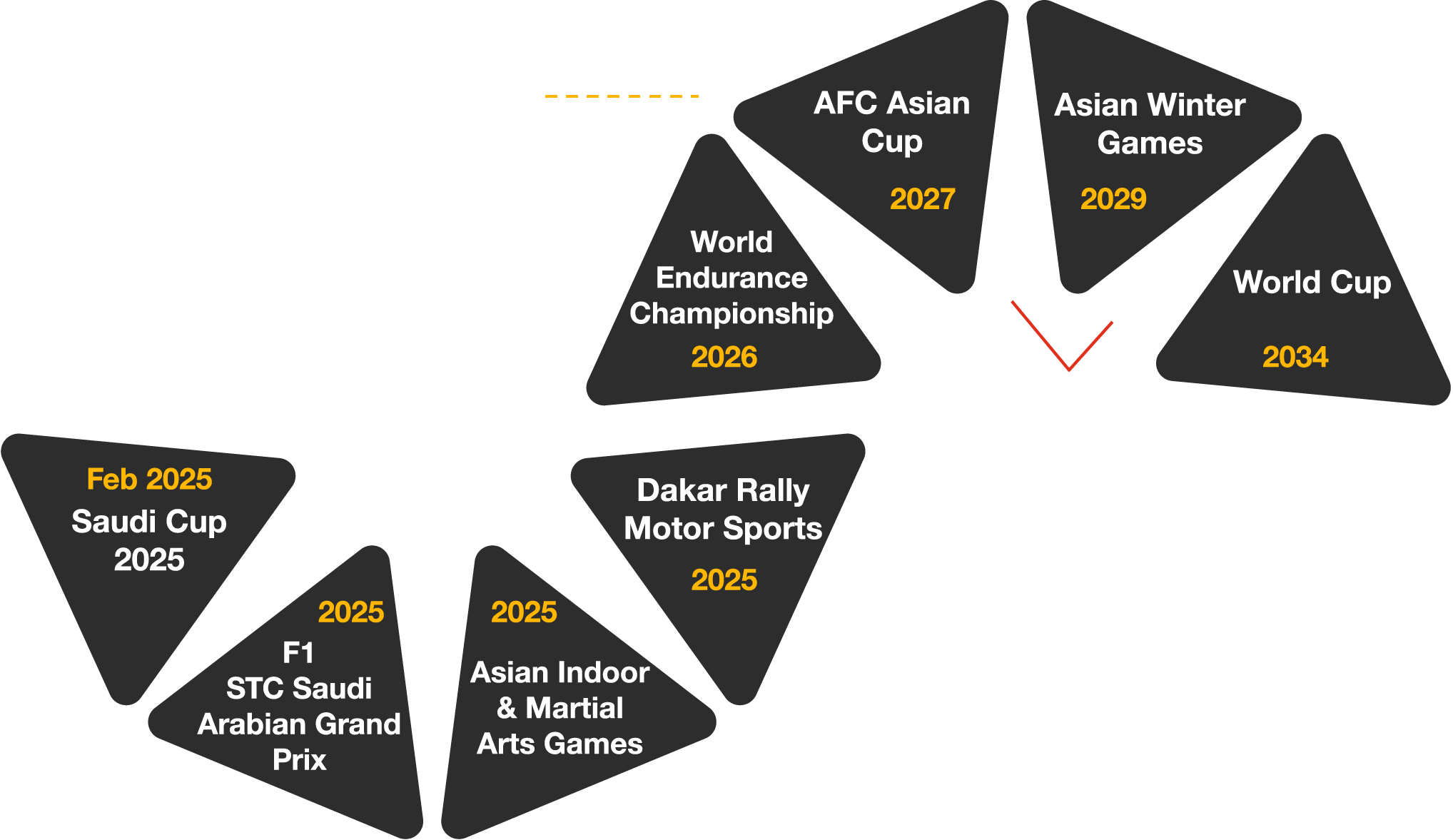Saudi Arabia’s major upcoming sport events
The Kingdom’s pipeline of major national and international events highlights KSA’s focus across seven key sports, presenting opportunities for technology adoption

Digital stadiums: Transforming the sports industry
The digital stadium sector is projected to witness significant growth, expanding by 20.6% annually between 2025 and 2037 to reach US$191.7 billion(2), driven by the need for more efficient stadium operations and demand for enhanced fan experiences.

Between 2020 and 2024, 18 stadiums were rebuilt and 32 new ones were constructed globally(4), as investment in physical assets has surged, rising from 4.5% to 6.2% of revenue and surpassing €800 million in 2023(4). Qatar’s 8% increase in real GDP in Q4 2022 highlights the substantial economic benefits of digital stadiums, which played a pivotal role in the country’s successful hosting of the 2022 FIFA World Cup(5).

Operational efficiency is a key advantage of digital stadiums, with AI-driven systems and Internet of Things (IoT) solutions streamlining event management and reducing costs. Predictive maintenance powered by AI can foresee equipment failures, allowing operators to pre-emptively address issues, reducing the need for costly repairs. Financially, these stadiums unlock new revenue streams through personalised advertising and data-driven, monetisable fan insights gathered from IoT sensors, which in turn increases spectator spending and drives higher returns for sponsors.
Sustainability and Environmental, Social, and Governance (ESG) alignment are important aspects in modern stadium design. AI and IoT optimise resource usage based on real-time needs, reducing both operational costs, energy consumption and environmental impact. For example, digital lighting systems adjust brightness based on crowd presence, and Heating, Ventilations and Air Conditioning (HVAC) systems automatically scale back in areas with lower occupancy, significantly lowering the stadium’s overall carbon footprint(6). AI-based lighting and HVAC management systems can achieve energy savings of up to 40%(7).

Advanced technologies such as facial recognition, real-time crowd monitoring sensors and anti-drone systems are also enhancing safety and security for fans, staff and players at digital stadiums. During the 2022 World Cup, AI-driven cybersecurity measures and crowd management tools were instrumental in ensuring a secure event, highlighting the value of these investments.

Way forward
The integration of innovative technologies within Saudi Arabia’s stadiums marks a transformative leap forward, promising to redefine fan engagement and operational efficiency.
Several key elements must be prioritised to drive this transformation:
1. Create unique value propositions
To elevate Saudi stadiums into advanced digital environments, we propose a comprehensive digital strategy integrating technologies like AI, IoT, and drones. This strategy should establish standardisation protocols that define what a "digital stadium" entails, supported by a customised enterprise architecture blueprint and a detailed handbook. By doing so, operators can ensure smooth and cohesive technology adoption across all touchpoints. In parallel, a national data governance framework should be implemented to address data privacy and security concerns. Implementing measures such as end-to-end encryption, multi-factor authentication and AI-driven threat detection systems can protect fans' personal information, build trust, and ensure compliance with global privacy standards.
2. Design tailored user experiences
Identifying user personas and meticulously mapping their digital journeys is a critical step towards driving fan engagement. Tailoring experiences to align with these personas – through platforms such as interactive mobile apps, augmented reality (AR) features, and digital twins – will optimise satisfaction and enhance immersion. Given the diversity of fan bases, digital inclusion will be vital. Initiatives including multilingual support and on-site assistance can empower fans of all technological backgrounds. Additionally, implementing multi-channel engagement options like QR codes can accommodate varying levels of tech readiness, ensuring a seamless experience.
3. Build immersive technology and infrastructure
Transforming stadium operations requires the deployment of cutting-edge technologies, such as digital twins, data analytics dashboards, and AI-powered applications. These innovations enable real-time optimisation of processes, from crowd management to improving operational efficiency. To address challenges such as system obsolescence, adopting a scalable, cloud-based technology is essential to ensure continuous upgrades and reduce hardware dependency, future-proofing stadium infrastructure. To maintain system reliability and prevent failures, operators should establish redundant systems, automated failover mechanisms, and AI-driven monitoring tools. Robust disaster recovery frameworks ensure operational continuity, even during unexpected outages.
Digital stadiums
Transforming sports and fan experiences with technology in Saudi Arabia
الملاعب الرقمية
تطور الرياضة وتجارب المشجعين باستخدام تقنيات متقدمة في المملكة العربية السعودية
















